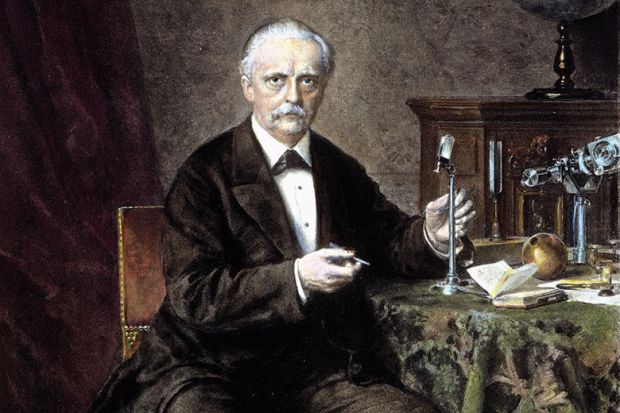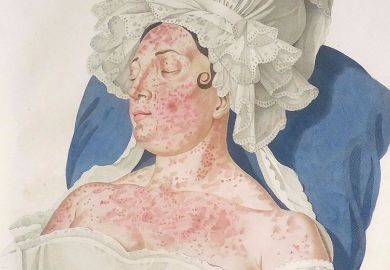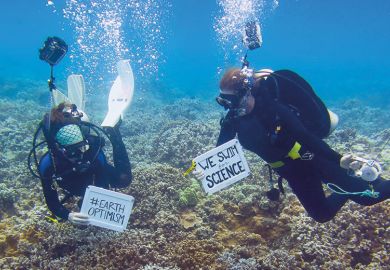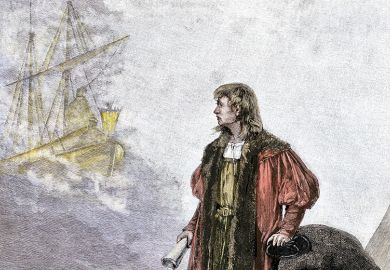University of Nebraska-Lincoln historian David Cahan’s biography of 19th-century scientist Hermann von Helmholtz is massive, weighing in at 1.83kg, or 4lb in old money. Helmholtz’s work definitely justifies a substantial study. However, I believe that inside Cahan’s book is a shorter, better volume crying to get out.
Helmholtz was born in Potsdam in 1821 and trained as a medical doctor in nearby Berlin, then the capital of Prussia. He contributed extensively to animal and human physiology and recognised the importance of conservation of energy, producing an early statement of what is now known as the first law of thermodynamics. He constructed the first instrument successfully to allow examination of the human retina, his ophthalmoscope. He worked on the theory and mechanisms of colour vision, on non-Euclidean geometry, on the physiological basis of music, and he wrote influentially on the relations between science and philosophy, particularly that of Immanuel Kant. He transformed himself into a theoretical physicist and was regarded as an equal by William Thomson (Lord Kelvin) and James Clerk Maxwell for his work in hydrodynamics and electrodynamics. His Handbuch der physiologischen Optik, published in three volumes in 1856-66, became a standard work and was translated into English and French. He also gave many lectures on science to the general public. Helmholtz’s overall contributions, both in breadth and depth, have rarely been equalled – he was a scientific and intellectual superstar.
After Berlin, his career took him to Konigsberg, which had been the Prussian capital until 1701, where he was appointed extraordinary (associate) professor of physiology in 1848. By 1855, he was ordinary (full) professor of anatomy and physiology in Bonn (Rhine Province of Prussia), moving in 1858 to Heidelberg, in the Grand Duchy of Baden. In 1871, he returned to Berlin, newly created capital of the German Empire, as professor of physics and institute director.
Cahan’s declared intention, following a chronological approach, is to portray both Helmholtz’s life and his work, exploring these in the wider context of 19th-century science and culture. With such broad aims, there are inevitably issues of balance.
Helmholtz: A Life in Science seems to me to exemplify a trend in academic biographies of scientists, where social history predominates and the science of the subject takes second place. The book is absorbing as a description of 19th-century German university politics. Then, as now, states and local governments were much involved in academic appointments, which could become tortuous to an extent that is unfamiliar in the UK or the US. Helmholtz seems to have been quite good, pre-unification, at playing one government off against another. The Franco-Prussian war of 1871 and the subsequent unification of Germany were events of major significance to Helmholtz and to all Germans, which the book also treats very well.
We learn a lot about Helmholtz’s life and less about his work. One example will suffice. In 1851, aged 30, Helmholtz built the instrument that made his name. Through his ophthalmoscope, he became the first person able to see the human retina. The new device started a beneficial revolution in the analysis, diagnosis and treatment of eye disease, yet Cahan describes its invention and construction in less than one page and provides no diagram to show how it works. Helmholtz told his father that he learned the optics necessary to construct the ophthalmoscope at his gymnasium (secondary school), so the principles involved cannot be too abstruse. Instead of detailing them, however, Cahan gives us six pages describing a tour that Helmholtz took to promote the instrument. (En passant, you may ask about the Helmholtz coil, an important piece of kit used to produce a region of uniform magnetic field. This was invented by someone else and named in Helmholtz’s honour. It is not mentioned in this book.)
Cahan is exhaustive on Helmholtz’s life outside the lab. We are spared no detail of where he went on business and on holiday. We are told how he travelled, what the weather was like (in England it rained a lot), where he stayed, who he met and, sometimes, what they ate. We are even told of some people he never met (Bismarck). We know who he wrote letters to as well as what music he listened to (Wagner) and played (Bach fugues on a Steinway piano serviced personally by a senior member of the Steinway family). Put simply, we are told too much, at a length that becomes tedious. We are only rarely given any detail of what specific questions he worked on at a particular time, and we discover nothing about how he recorded or organised his experimental results. I open the biography of a scientist expecting that it will tell me what they achieved but also hoping that it will offer some insight into how and why they got there. I learned very little about the thought processes or motivation of this great man.
One thing slightly surprised me. Only 30 years after the construction of the first steam railway, travel across countries and continents had become part of everyday life, at least for the well-off. As a result, Helmholtz’s life as a scientific grandee (Cahan’s term) had much in common with that of the two or three superstars that I have been privileged to know in my own career (none of whom aspired to grandee status). He was a workaholic to the extent that his health suffered. He regularly met and had discussions with other superstars, wanting to know their opinions, although these rarely altered his own. He cared about who received honours and awards, gaining many himself. His laboratory became a magnet for good young scientists, especially after his move to Berlin. Unlike today’s superstars, he was unable to hand over much of his teaching or administration, and he was involved in priority disputes to an extent that is now unusual. He networked very well with other superstars, but less effectively with the other ranks.
The skill that he showed in operating across so many disciplinary boundaries would make him a rarity today.
Some superstars are charismatic individuals who give inspiring lectures; others, such as Helmholtz, are not. Max Planck came to study with him in 1877 but stayed only one term. Helmholtz’s lectures, he noted, were “never properly prepared and he himself seemed to be at least as bored as we were”. I believe it is rare that a scientist’s personality offers much insight into their work. Helmholtz sought to create overarching, revolutionary scientific laws, yet in his personal life seems to have been rigidly conventional. He was strongly Anglophile throughout his life and equally Francophobe until 1871. He refused to condemn the antisemitism that flared up Berlin in the 1870s, despite the urging of his lifelong friend Emil du Bois-Reymond.
Helmholtz is now remembered by ophthalmic opticians and physicists as well as through the prestigious Helmholtz Research Institutes in Germany, but his is no longer a household name. He lived at the apogee of what is now labelled classical physics, dying in 1894. Only six years later, Planck published his revolutionary paper on black body radiation. That turned physical science upside down and began the quantum era of modern physics. Who can tell whether this accident of timing makes Helmholtz lucky or unlucky?
Richard Joyner is emeritus professor of chemistry at Nottingham Trent University.
Helmholtz: A Life in Science
By David Cahan
University of Chicago Press
944pp, £41.00
ISBN 9780226481142
Published 23 October 2018
The author
David Cahan, Charles Bessey professor of history at the University of Nebraska-Lincoln, was born and grew up in Chicago. He majored in philosophy at the University of California, Berkeley, where he “experienced what first-rate scientists and scholars were like” and enjoyed “the sometimes unhinged but intellectually refreshing cultural atmosphere that was Berkeley in the late 1960s and early 1970s”. Yet it was Johns Hopkins University in Baltimore, where he gained a PhD in history of science, that “gave [him] the sort of professional guardrails that I needed: the programme in history of science taught me how to become an academic researcher; brought me to the forefront of current scholarship; and introduced me to many of the professional leaders in the field”.
Cahan has devoted much of his career to Helmholtz. Although he was “widely considered as being among the handful of most important scientists of the 19th century”, the best biography dates back to 1902-03 and is “a hagiographical, life-and-letters treatment”. Finding “a terrific set of personal letters, which I edited and published as Letters of Hermann von Helmholtz to His Parents: The Medical Education of a German Scientist, 1837-1846 [1993]”, and then many more, enabled him to “write a biography that mixed science with the man: to show his personal and familial life and much else” and helped him to “present the ‘real’ life of a scientist – a person with hopes, desires, strengths, weaknesses, etc”.
As for wider lessons of Helmholtz’s career, Cahan claims that “outstanding, lifelong research in science requires much more than science itself. It also needs the nourishment that comes from the arts, the humanities and a full social life…to stimulate the most effective research today, one must seek to stimulate the emotional as well as the intellectual self of young (and not-so-young) scientists.”
Matthew Reisz
POSTSCRIPT:
Print headline: Grandee’s days out come at the cost of lab time
Register to continue
Why register?
- Registration is free and only takes a moment
- Once registered, you can read 3 articles a month
- Sign up for our newsletter
Subscribe
Or subscribe for unlimited access to:
- Unlimited access to news, views, insights & reviews
- Digital editions
- Digital access to THE’s university and college rankings analysis
Already registered or a current subscriber?








